Romney Marsh Countryside Partnership
Wildlife Ponds
Perhaps more than any other addition, a new pond will attract a huge array of wildlife into your garden.
From the strangest of insects to breeding amphibians and hungry grass snakes, a well managed wildlife pond will provide a seemingly endless source of fascination for both adults and children alike.
Positioning Your Garden Pond
Try to site the pond in an area that gets a good proportion of sunshine. Exposure to sunlight in the spring will warm the water and help promote rapid plant growth. Some shelter from the prevailing wind like a fence of earth bund will also help. Remember that long surrounding vegetation is important for animals using the pond and so try to place the pond in an area where you are happy to encourage a less tidy look around part of the perimeter. Also bear in mind that ponds positioned under trees don’t just suffer adversely from shade – leaves falling into a pond from overhanging branches will create a dark, dank and sludgy environment low in oxygen. Surface roots from nearby trees can also puncture pond liners.
Other things to consider before construction begins:
- Can it be topped up from a natural source of rainwater (e.g. off a shed roof)
- Is the site level – if not one side will be exposed when the pond is filled.
- Build as big a pond as room will allow. A surface area of 4 to 5 square metres is a good minimum size although smaller ponds are still of value.
How To Construct Your Wildlife Pond
Now you’re ready for some serious exercise! Just remember all the digging will be worthwhile in the end.
Although there are various construction methods available we recommend the use of a flexible liner for a garden wildlife pond following the method described below.
Aim for a maximum pond depth of at least 75cm – very shallow ponds will tend to dry out too early in the summer and freeze solid in the winter. Dig the pond 15cm deeper than the intended final depth to allow for a protective layer below the liner and a covering of soil on top.
An informal shape works best for a wildlife pond with circular, oval or kidney shapes being the easiest to construct. Dig a profile with gently sloping sides which will hold the backfilled soil and also allow animals like frogs an easy access and exit to the pond.
Remove all obvious stones or other sharp objects from the excavated hole and line it with a 5cm layer of builders sand, old carpet, thick newspaper or polypropylene matting to prevent the liner from being punctured by sharp stones. Bury the exposed edges of the liner in a spade-width trench around the pond perimeter.
To work out how big a liner you need use the following formulas:
length of liner = maximum pond length + twice maximum depth
width of liner = maximum pond width + twice maximum depth
Example: a pond 3m long and 2m wide with a maximum depth of 1m requires a liner 5m long by 4m wide.
Cover the liner with at least a 10cm layer of subsoil, again being careful not to puncture the liner with any sharp stones. You can always cover the upper surface of the liner with another protective layer of lining material as an added protection before backfilling. Avoid using topsoil which is too nutrient rich and could lead to vigourous algal growth.
If the pond is constructed in early Autumn allow it to fill naturally with rainwater during the winter ready for planting the following spring. If you are constructing during the spring and want to fill the pond using a hosepipe, leave the water to settle for at least a couple of weeks prior to planting.
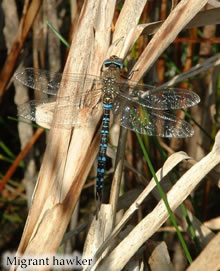
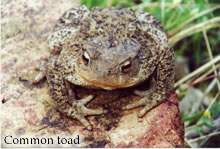
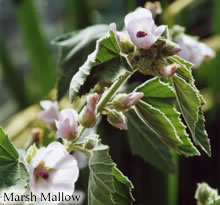
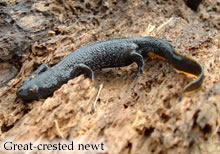
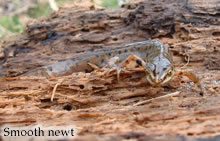
Stocking Your Pond With Plants
Now you’re ready for the fun bit. For a healthy pond ecosystem you will need to use a range of plants of various types including oxygenators, emergents and marginals. A good mix of submerged oxygentors is particularly important for the health of the pond and includes plants such as water milfoil, hornwort and water starwort.
A selection of suitable pond plants is listed below. All these can be planted directly into the backfilled soil of the pond being careful not to puncture the liner. Plant emergents in the deeper water of the pond from where they will send up leaves and flowers to break the water surface. As you approach the shallows and muddy margins you can start to introduce the marginals and wildflowers that prefer marshy conditions.
Stocking Your Pond With Creatures
The establishment of a rich animal community takes time so try to be patient. It is frowned upon to move amphibians or their spawn around ponds which can spread disease. Please don’t take animals from the wild. It’s always better to let nature take its course.
Some publications talk about introducing a bucket of mud from an established pond to seed the new pond with creatures. Remember that if you want a fish free pond, introducing a bucket of mud from another pond is probably the easiest way to transferring fish eggs from one site to another. The same also applies to plants – don’t move plants from a friend’s goldfish pond into your own – they could well have fish eggs hiding in the leaves!
When Should I Clear Out My Pond?
The time of the year to do any major tidying up is the autumn. All the amphibians have generally left the pond by this time. The larval stages of many creatures have also finished developing and for natural ponds, the water level is also at its lowest. Also remember that it is best to remove overgrown plant material in small quantities every year rather than tackle it in a single large operation once every few years which creates a greater degree of disturbance.
Oxygenators
Myriophyllum spicatum (Water Milfoil)
Potamogeton crispus (Curled Pondweed)
Ceratophyllum demersum (Rigid Hornwort)
Callitriche species (Water Starwort)
Emergents
Menyanthes trifoliata (Bog Bean)
Polygonum amphibium (Amphibious Bistort)
Sagittaria sagittifolia (Arrowhead)
Hydrocharis morsus-ranae (Frogbit)
Ranunculus lingua (Greater Spearwort)
Marginals
Butomus umbellatus (Flowering Rush)
Veronica beccabunga (Brooklime)
Myosotis scorpioides (Water Forget-Me-Not)
Mentha aquatica (Water Mint)
Iris pseudacorus (Yellow Flag)
Marsh Plants
Cardamine pretense (Lady’s Smock)
Eupatorium cannabinum (Hemp Agrimony)
Lythrum salicaria (Purple Loosestife)
Lychnis flos-cuculi (Ragged Robin)
Althaea officinalis (Marsh Mallow)
Lycopus europeaus (Gypsywort)
Potential Problems – Fish and Algae
Two of the biggest obstacles to creating the perfect wildlife pond are fish and algae.
If you stock your newly created pond with fish they will devour all manner of aquatic life including tadpoles. Therefore, do not introduce fish of any kind into your wildlife pond, even native species such as sticklebacks
Green algae can also be a serious problem in garden ponds during the summer months. Nutrient rich tap water will encourage strong algal growth so avoid using it to top up the pond if you can. If you can feed your pond with a regular source of rainwater so much the better. Young ponds are particularly susceptible to algal blooms before other plants have had a chance to establish. Try and be patient as the situation will get better as the plants and pond matures.
If you want to get rid of green algae scoop out as much as you can and leave it on the side of the pond for trapped animals to escape before removal. The most acceptable method for dealing with problem algal blooms is to introduce bundles of barley straw just below the surface contained in a net bag. Resist the temptation to resort to short-term chemical controls to rid yourself of algae.
What Can I Expect To See In My Pond?
The Romney Marsh holds excellent populations of the rare great-crested newt. Over 110 natural ponds hold the species and at least that figure again in garden ponds through Lydd, New Romney, Dymchurch and up to Hythe. Great crested newts are particularly sensitive to the presence of fish and therefore will tend to avoid many garden ponds. Great-crested newts are the largest of the three species of newt to be found in Britian.
Smooth Newts are the commonest and smallest of the newt species with an olive-green colour to the bodies. Although more tolerant of fish, they will still suffer greatly from fish predation.
Keep an eye out for the largest of the British diving beetles, the Great Diving Beetle (Dytiscus) and Great Silver Beetle (Hydrophoiolus) which could appear in your pond. They are spectacular in swimming around at great speed and although they eat small tadpoles, your pond will be a richer place if they remain.
Common Frogs are scarce in the farmland on the Romney Marsh but there are good spawning sites in garden ponds in more built up areas like New Romney and Dymchurch. Common frogs favour shallow ponds for spawning, therefore making garden ponds ideal. This leaves the larger non-native Marsh Frog to the deeper ditches, channels and ponds across the Marsh.
Toads like exploring gardens and are always found in unexpected places such as empty flower pots and drains. However, toads prefer to breed in sparse large ditches and the shallow edges of large ponds. Their long strings of spawn are sometimes overlooked being submerged amongst the vegetation. Toads tend to be fussy about spawning sites and do not always make use new ponds, favouring old established sites in the countryside. However, they will explore gardens during the summer and autumn, eating their way through vast quantities of slugs and snails and so are well worth encouraging.
